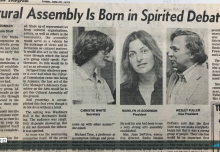
In the usual course of things, we at ArtsWorcester get a lot of questions. Through these questions, we learn that how we produce exhibitions is sometimes a mystery to artists and gallery-goers alike. In these posts, we answer some of the questions we are most often asked. Send in what seems like a mystery to you to Allie (allie “at” artsworcester.org), and we’ll answer your questions!
What is the difference between a members’ exhibition and a juried exhibition?
In a nutshell: one is open, and one is competitive.
A members’ exhibition shows the work of our artist members as a collective, and includes a single artwork from every artist member who chooses to participate in it. (Remember, everyone is eligible to become an artist member of ArtsWorcester, so it’s an open show of an open membership.)
Some member exhibitions have themes, ideas that unify the exhibition and gives artists ways to think about the art they make or choose for the exhibition. Themes give first the exhibit designer and then gallery-goers ways to look at and consider the artworks in relationship to each other. One exhibition each year, the annual “One,” has no theme, and invites artists simply to register the single artwork they want to show the most.
Every artist member, regardless of the length of their membership or experience with exhibition, may register an artwork for a member exhibition that fits size limits and relates to the theme, if any. These are the biggest and most complex exhibitions we produce, involving between one hundred and two hundred and fifty artists each.
A juried exhibition shows artwork selected through a competitive process. Artist members submit images and information for the artworks they hope will be selected by the juror. A juror is responsible for reviewing all the submissions, and determining which of the artworks will be declined, accepted, or awarded additional prizes. (In some organizations, a jury of two or more people work together to make selections and give prizes.) At ArtsWorcester, the initial submissions are usually reviewed electronically, and the juror makes their final decisions about the exhibition and awards while looking at the artwork in person. The Biennial and the College Show are our most frequent juried exhibitions.
We provide the juror some basic guidelines: an ideal range for the number of pieces they select (determined by the intended gallery space), or whether we have a preference for including more artists with fewer works, or more works by a smaller number of artists (answer: it depends). Then, the juror determines and uses their own criteria for selection. In this way, a juried exhibition is always created to a large degree by a subjective sets of standards and individual taste. At ArtsWorcester, the jurors are not provided with the names of artists or any other identifying information, a process known as a “blind jurying.”
The juror’s selection process usually takes several hours of individual review. They then make their final choices for exhibition, and determine awards, in the week before the exhibition opens, as it is installed in the galleries. They provide, either in discussion or in a written statement, explanations of their approach to the exhibition, and the criteria they used for selection and awards. They are thanked for their service with an honorarium of a few hundred dollars (and lunch, if they accept). They may or may not attend the opening, depending on their schedules and how open they are to the advances of artists whose work was either accepted or declined for exhibition.
>> Next up: Who are these jurors, and how do they become one?
Above image: In Transition: A Members’ Exhibition in partnership with the Fitchburg Art Museum, Spring 2020.




